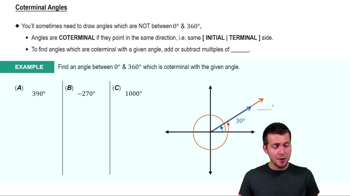Table of contents
- 0. Review of College Algebra4h 43m
- 1. Measuring Angles39m
- 2. Trigonometric Functions on Right Triangles2h 5m
- 3. Unit Circle1h 19m
- 4. Graphing Trigonometric Functions1h 19m
- 5. Inverse Trigonometric Functions and Basic Trigonometric Equations1h 41m
- 6. Trigonometric Identities and More Equations2h 34m
- 7. Non-Right Triangles1h 38m
- 8. Vectors2h 25m
- 9. Polar Equations2h 5m
- 10. Parametric Equations1h 6m
- 11. Graphing Complex Numbers1h 7m
1. Measuring Angles
Angles in Standard Position
Problem 12a
Textbook Question
In Exercises 8–12, draw each angle in standard position. -135°
 Verified step by step guidance
Verified step by step guidance1
Start by understanding that an angle in standard position has its vertex at the origin of the coordinate plane and its initial side along the positive x-axis.
Recognize that a negative angle is measured clockwise from the positive x-axis.
To draw -135°, begin at the positive x-axis and rotate clockwise.
Since -135° is more than -90° but less than -180°, the terminal side will be in the third quadrant.
Draw the terminal side of the angle such that it forms a 135° angle with the positive x-axis in the clockwise direction.
Recommended similar problem, with video answer:
 Verified Solution
Verified SolutionThis video solution was recommended by our tutors as helpful for the problem above
Video duration:
2mPlay a video:
Was this helpful?
Key Concepts
Here are the essential concepts you must grasp in order to answer the question correctly.
Standard Position of an Angle
An angle is said to be in standard position when its vertex is at the origin of a coordinate system and its initial side lies along the positive x-axis. The angle is measured from the initial side to the terminal side, which is determined by the direction and magnitude of the angle. Positive angles are measured counterclockwise, while negative angles are measured clockwise.
Recommended video:

Drawing Angles in Standard Position
Negative Angles
Negative angles are formed by rotating clockwise from the positive x-axis. For example, an angle of -135° indicates a rotation of 135° in the clockwise direction. Understanding how to visualize and draw negative angles is crucial for accurately representing them in standard position.
Recommended video:

Coterminal Angles
Quadrants of the Coordinate Plane
The coordinate plane is divided into four quadrants, each defined by the signs of the x and y coordinates. Quadrant I contains positive x and y values, Quadrant II has negative x and positive y values, Quadrant III has negative x and y values, and Quadrant IV has positive x and negative y values. Knowing which quadrant an angle lies in helps in determining the coordinates of points on the terminal side of the angle.
Recommended video:

Quadratic Formula

 5:50m
5:50mWatch next
Master Drawing Angles in Standard Position with a bite sized video explanation from Patrick Ford
Start learningRelated Videos
Related Practice












